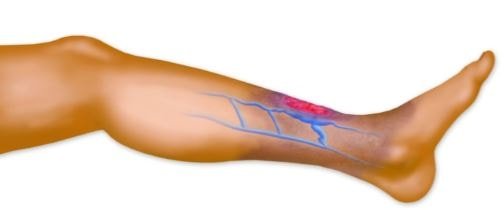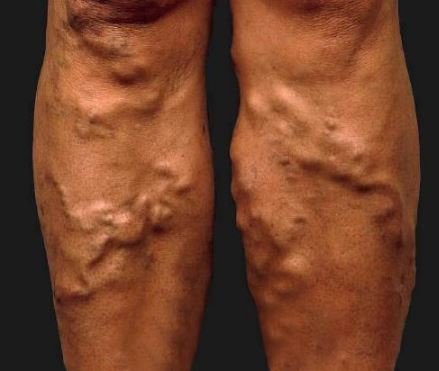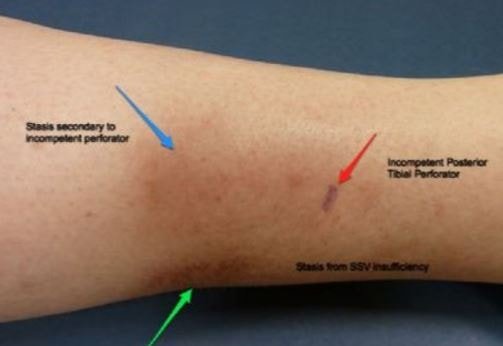Blood Clot in Leg
What is blood clot in leg?
Blood clot in a leg is symptomatic approach of deep vein thrombosis. This initial symptom may not be life threatening, but untreated condition cause mobilization of clot to lung and causing a pulmonary embolism (PE) and cause serious health issue. Prolonged traveling in the bus or airplane, where the leg space is narrow and difficult to move can cause blood clot in leg, this is preventable by moving around for a short stroll. (1)

Associated signs & symptoms
Usually blood clot in the leg does not possess associated symptoms and person suffers with this may asymptomatic. When this becomes a serious health problem, then need immediate medical attention. Following are some associated symptoms may develop in some individuals.
Redness
Slight discoloration of the skin at the site of clotting is an initial symptom. This discoloration is formed due to blood accumulated in the localized vein present just beneath the skin surface of the affected site of the leg. This is clearly superficially visible .
After any surgery or injury, it is possible to develop red patches in the leg, which cannot go away with time or more intense with increase duration. This symptom needs immediate medical attention.
Inflammation
Inflammation with pain symptoms is common in the leg, specifically at the calf muscle or ankle joint. In these areas, dense muscle fibers and bony structures prevent easy removal of blood clot. This discomfort is not associated with any external injury or obvious cause and cannot be reduced with usual treatment such as hot or cold compression.
Warmth
The temperature of the affected site is usually higher than the normal temperature. This may cause itching or throbbing sensation.
Fainting
Sudden fainting or black out occurs, if the clot is not decomposed naturally and move towards lung. This increases the respiration load and breathing difficulty is common. Usually fainting is common during posture change such as sitting or laying down position to standing position. Sudden fainting can cause injury. Consultation with a doctor is very essential for such type of unconsciousness.
Chest pain and abnormal heart rate
When blood clotted in a certain localized area, then usually blood flows forcefully for disintegrate the clot. Heart pumps harder and faster than the normal to maintain the forceful blood circulation. This increases heart rate. If the blood clot cannot disintegrate, then it moves to any other part of the body. If this movers towards lung or heart, then chest pain is a usual symptom.
Medical attention is needed to control the situation, otherwise psychological stress or panic condition worse the situation.
Fatigue
Fatigue can be associated with blood clot in the leg, because of body defense mechanism is not working adequately due to obstacle in blood circulation.
Fever
Mild fever and headache can be associated with blood clot in the leg. The temperature when lower down, then it can cause sweating or chills. Low appetite is also associated.
Tenderness
Tenderness can feel during touching of the site. Sometime veins are visible from the skin surface.
Distended vein
The distended vein can develop with blood clot in the leg. This occurs, when the size of the clot is large and it may cause rupture of the surrounding blood vessel. (1, 3)
Blood Clot in Leg Causes
The usual causes of clot in leg is due to the following reasons
Deep vein thrombosis (DVT)
DVT develops due to clot formation in the blood vessel, usually in the vein. Veins present is leg are mainly affected at initial phase.

Factor V Leiden
Factor V Leiden is formed due to mutation of blood clotting factor V, which causes abnormality in blood clotting and cause clot formation in the vein.
Obesity
Obesity means increase body fat which relate with increase body weight. Leg usually hold the body weight. Leg of a obese person has to bear more body weight than the normal and this heavy weight can cause blood clot in leg. Other than this cardiovascular problem is common in obesity and which also hamper the usual blood circulation.
Peripheral artery disease
Peripheral artery disease causes narrowing of the artery and hinders blood circulation in the limbs and adequate blood is not reached in the legs and cause pain.

Polycythemia vera
Polycythemia vera is a type of malignancy. Bone marrow produces the maximum number of red blood cells and also affects other cellular components, including white blood cells and platelets. Resultant of this is unusual blood clotting. (2)
Diagnosis
The initial diagnosis is started with detail discussion of symptoms and medical history. Then usually, physical examination is another approach to detecting the sit and extended area of blood clot in leg. Then following tests are conducting for detail diagnosis of the condition:
Duplex ultrasound
This test is conducted over the clot area in leg to get the imaging of blood vessels and clot trapped inside the vein or artery. This is helpful to detect even the deep sited clot present inside the vein. This is a painless test and skill personnel can understand the whole etiology of the clot in the leg.
Venography
This is a specialized technique to take the imaging of veins and clot trapped inside it. Radioactive dye is injected in the vein located on the above portion of the foot and then X-ray images are taken for diagnosis purpose.
Blood test
Blood test is conducted to check the total blood count, and abnormal increase findings of red blood cells count can also need a further estimation of hemoglobin, Hematocrit (Hct) Levels for diagnosing the polycythemeia vera.
Increase platelet count also causes abnormal blood clot.
MRI
In this test computerized imaging of whole body helps to detect the underlying cause of abnormal blood clotting (4).
Treatment
- Anti-coagulating medicines are provided for preventing clotting.
- Blood thinning medicine can be prescribed to dissolve the clot and promote blood circulation. (5)
Home remedies
The following home remedies can help to prevent and treat blood clot in the leg
- Walking for short interval can cause relaxation of the leg muscle and blood vessels, which promote blood circulation and prevent blood clotting.
- Little elevation of the leg can help to reduce the swelling and blood clot as it promotes blood flow from peripheral blood vessels towards the heart.
- Wearing of compressed stocking can help to decompose the blood clot and reduce inflammation. (5)
References
- Anna Fleet (2015), 10 Signs You May Have a Blood Clot in Your Leg; Retrieve from: http://www.activebeat.com/your-health/10-signs-you-may-have-a-blood-clot-in-your-leg/10/
- Mayo Clinic Staff (2013); Blood clots; Retrieve from: http://www.mayoclinic.org/symptoms/blood-clots/basics/causes/sym-20050850
- The Surgeon General’s Call to Action to Prevent Deep Vein Thrombosis and Pulmonary Embolism, US Dept of Health and Human Services, 2008. Retrieve from: https://www.stoptheclot.org/learn_more/blood_clot_symptoms__dvt.htm
- James Beckerman (2015), Deep Vein Thrombosis Health Center; Retrieve from: http://www.webmd.com/dvt/deep-vein-thrombosis-dvt-symptoms-diagnosis
- WebMD Medical Reference from Healthwise (2014); Deep Vein Thrombosis – Treatment Overview; Retrieve from: http://www.webmd.com/dvt/tc/deep-vein-thrombosis-treatment-overview
